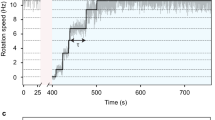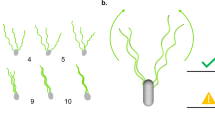Abstract
TETHERED bacteria1 rotate at the angular velocity at which the torque generated by the flagellar motor2 is balanced by the torque due to the viscous drag. In general, M = bηΩ, where M is the torque, η is the viscosity, Ω is the angular velocity, and b is a coefficient which depends on the size and the shape of the cell, the position of the axis of rotation, and the distance between the cell and the wall. For a sphere of radius a (not too close to the wall) M = 8πη a3Ω (ref. 3). Viscous forces are so large in comparison with inertial forces4 that Ω will change with M virtually instantaneously; any discontinuities in the one will be evident in the other. Consider a cell of radius a and uniform density ρ rotating at an angular velocity Ω0; if its motor is suddenly disengaged, Ω will decay exponentially to 0 with a time constant ρ a2/15η, and the cell will stop in Ωρ a2/15η radians. For Escherichia coli this is less than a millionth of a revolution. The cell also is subject to rotational diffusion, but this will be evident only if the coupling between the flagellum and the body of the cell is fluid. The root-mean-square deviation in the angular position is (2Dt)½, where D is the rotational diffusion constant and t is the time. For a cell which can rotate freely, D = kT/bη, where k is Boltzmann's constant and T is the absolute temperature.
This is a preview of subscription content, access via your institution
Access options
Subscribe to this journal
Receive 51 print issues and online access
$199.00 per year
only $3.90 per issue
Buy this article
- Purchase on Springer Link
- Instant access to full article PDF
Prices may be subject to local taxes which are calculated during checkout
Similar content being viewed by others
References
Silverman, M., and Simon, M., Nature, 249, 73–74 (1974).
Berg, H. C., and Anderson, R. A., Nature, 245, 380 (1973).
Landau, L. D., and Lifshitz, E. M., Fluid Mechanics, Ch. 2 (Pergamon, London, 1959).
Taylor, G., Proc. R. Soc., A 209, 447 (1951).
Berg, H. C., Rev. Sci. Iustrum., 42, 868 (1971).
Silverman, M., and Simon, M. I., J. Bact., 112, 986 (1972).
Armstrong, J. B., Adler, J., and Dahl, M. M., J. Bact., 93, 390 (1967).
Larsen, S. H., Reader, R. W., Kort, E. N., Tso, W.-W., and Adler, J., Nature, 249, 74–77 (1974).
Berg, H. C., and Brown, D. A., Nature, 239, 500 (1972).
Vaituzis, Z., and Doetsch, R. N., J. Bact., 89, 1586 (1965).
Vaituzis, Z., and Doetsch, R. N., J. Bact., 91, 2103 (1966).
Okrend, A. G., and Doetsch, R. N., Arch. Mikrobiol., 69, 69 (1969).
DePamphilis, M. L., and Adler, J., J. Bact., 105, 384 (1971).
DePamphilis, M. L., and Adler, J., J. Bact., 105, 396 (1971).
Larsen, S. H., Adler, J., Gargus, J. J., and Hogg, R. W., Proc. natn. Acad. Sci. U.S.A. (in the press).
Author information
Authors and Affiliations
Rights and permissions
About this article
Cite this article
BERG, H. Dynamic properties of bacterial flagellar motors. Nature 249, 77–79 (1974). https://doi.org/10.1038/249077a0
Received:
Issue Date:
DOI: https://doi.org/10.1038/249077a0
This article is cited by
-
Basal cognition: shifting the center of gravity (again)
Animal Cognition (2023)
-
Biocolloid transport and deposition in porous media: A review
Korean Journal of Chemical Engineering (2022)
-
Linear motor driven-rotary motion of a membrane-permeabilized ghost in Mycoplasma mobile
Scientific Reports (2018)
-
Applying torque to the Escherichia coli flagellar motor using magnetic tweezers
Scientific Reports (2017)
-
Native and artificial forisomes: functions and applications
Applied Microbiology and Biotechnology (2011)
Comments
By submitting a comment you agree to abide by our Terms and Community Guidelines. If you find something abusive or that does not comply with our terms or guidelines please flag it as inappropriate.



